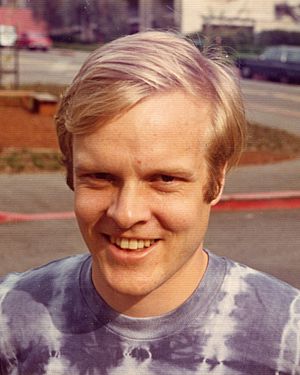Per Enflo facts for kids
Quick facts for kids
Per Enflo
|
|
|---|---|

Enflo in 1972
|
|
| Born | 20 May 1944 |
| Alma mater | Stockholm University |
| Known for | Approximation problem Schauder basis Hilbert's fifth problem (infinite-dimensional) uniformly convex renorms of super-reflexive Banach spaces embedding metric spaces (unbounded distortion of cube) "Concentration" of polynomials at low degree Invariant subspace problem |
| Awards | Mazur's "live goose" for solving "Scottish Book" Problem 153 |
| Scientific career | |
| Fields | Functional analysis Operator theory Analytic number theory |
| Institutions | University of California, Berkeley Stanford University École Polytechnique, Paris The Royal Institute of Technology, Stockholm Kent State University |
| Doctoral advisor | Hans Rådström |
| Doctoral students | Angela Spalsbury Bruce Reznick |
Per H. Enflo, born on May 20, 1944, is a Swedish mathematician. He is famous for solving very difficult problems in a field of math called functional analysis. These problems had puzzled mathematicians for over 40 years!
He solved three major problems:
- The basis problem
- The approximation problem
- The invariant subspace problem for Banach spaces
When Per Enflo solved these problems, he created new ways of thinking about math. These new methods were then used by other scientists. His work has also been important in other areas. These include number theory and computer science. He helped with computer algebra and approximation algorithms.
Today, Enflo works at Kent State University as a University Professor. He has also worked at other famous universities. These include the University of California, Berkeley and Stanford University. He also taught at École Polytechnique in Paris.
Math and Living Things
Per Enflo has also used math to study living things. This field is called mathematical biology. He has written papers about how populations of animals or plants change over time. This is known as population dynamics.
How Humans Evolved
Enflo has also studied how humans have changed over many years. This involves population genetics and paleoanthropology.
Today, all humans are part of one group called Homo sapiens sapiens. Scientists believe the first human-like species, Homo habilis, appeared in East Africa about 2 million years ago. These early humans spread across Africa. Later, Homo erectus evolved and spread across the world.
Scientists have different ideas about how modern humans developed. One idea is the "Out of Africa" model. This suggests that modern humans first evolved only in East Africa. Then, they moved out of Africa and replaced other human groups. Another idea is the "Multiregional Evolution" hypothesis. This suggests that humans evolved in many different places at the same time.
Neanderthals were another type of human. They lived in Europe at the same time as early modern humans. This period lasted for thousands of years. Modern humans may have arrived in Europe about 40,000 to 43,000 years ago. Neanderthals might have lived as recently as 24,000 years ago.
Per Enflo, with other scientists, looked at fossil evidence and DNA from Neanderthals and modern humans. Their work helps explain how Neanderthals might have disappeared. They suggested that modern humans kept moving into Europe. This might have led to modern human DNA mixing with Neanderthal DNA.
Enflo has also written about how zebra mussels populations grow. He studied them in Lake Erie.

A Talented Pianist
Per Enflo is not just a mathematician; he is also a talented concert pianist.
He was very good at both music and math from a young age. He won a Swedish competition for young pianists in 1956 when he was 11. He won it again in 1961. At age 12, he played as a soloist with the Royal Opera Orchestra of Sweden. He played his first concert at the Stockholm Concert Hall in 1963.
In 1999, Enflo took part in a piano competition. It was for "Outstanding Amateurs" and was held by the Van Cliburn Foundation.
Enflo often performs in Kent, Ohio. He also plays in a Mozart music series in Columbus, Ohio. His solo piano concerts have been played on the radio station WOSU-FM.
External Sources
- Biography of Per Enflo at Canisius College
- Homepage of Per Enflo at Kent State University
- Per Enflo at the Mathematics Genealogy Project

